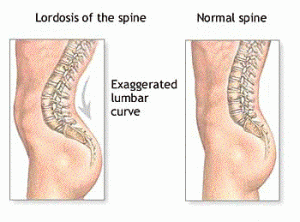The term lordosis means inward curving of a part of the lumber and cervical vertebral column. Excessive lordosis is termed as swayback or saddle back. There are three types of curves which can be present in the human spine.
Scoliotic curves- sideways curvature of the spine; it is always abnormal
Lordotic curves- inward curve of the lumbar spine just above the buttocks
Kyphotic curves- outward curve of the thoracic spine at the level of ribs
A small degree of lordosis and kyphoysis is normally present in the spine. If kyphoysis is too much, it causes round shoulders and is termed as Scheuermann’disease. If lordotic curving is too much, it is termed as swayback or lordosis that makes the buttocks more prominent.

Children suffering from too much lordosis will have a space beneath their lower back when lying on their back on a hard surface. When lordotic curve is flexible, it is generally not a concern. When the curve does not move, medical evaluationis needed. Lumber and cervical segments of the vertebral column are normally lordotic (convexity anteriorly and concavity posteriorly). Anterior pelvic tilt is a major factor of lordosis. Patients with lordosis often show a visible arch in their lower backs. When we look at them from the side, their lower back forms a defined C-shape.
People with lordosis seem to be sticking out their stomachs and buttocks. During examination of the patient with lordosis, ask the patient to lie on his or her back on a hard surface. Can the patient can slide his or her hand under lower back, with a little space to spare? If the patient has lordosis, he or she will have extra space between his or her hand and lower back2,3.
Causes of Lordosis
There are many medical conditions that cause the spine to curve more than normal. These conditions include.
- Achondroplasia- bones do not grow normally, leading to the short stature.
- Spondylolisthesis- the vertebrae in the lower back slip forward.
- Osteoporosis- vertebra become fragile and can easily be broken.
- Obesity- can cause lordosis.
- Kyphoysis- can lead to lordosis
- Discitis- the inflammation of intervertebral disc
- Benign juvenile lordosis
- Tight lower back muscles
- Excessive visceral fat
- Pregnancy
- Rickets
Lordosis symptoms
Symptoms of this abnormality depend upon the severity of the disease. Lordosis symptoms may include:
- C-shape back when seen from a lateral aspect, with the buttocks being more prominent
- A large gap between the lower back and the floor when lying on one’s back
- Pain and discomfort in the lower back
- Problems in moving in certain ways.
Diagnosis
It is difficult to measure and diagnose lordosis. The traditional measurement of lumber lordosis is difficult because of the obliteration of the vertebral end plate landmarks by interbody fusion. L4 –L5 and L5- S1 levels are mostly involved in fusion process, and contribute to normal lumber lordosis. It is useful to identify an accurate means of measuring lordosis at these levels.
Treatment
Treatment of lordosis includes:
- Pain killer medications to relieve the discomfort and back pain
- Wearing a back brace
- Weight loss
- Vitamin D supplementation
- Surgery
- Lordosis exercises

Post a comment